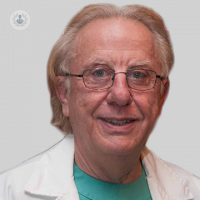Dental implants in the oncologic patient
Written by:
What are dental implants and what is their placement?
Dental implants are metallic structures of pure titanium, many of them covered by substances that enhance the union of the implant to the bone and has the shape of a screw. The surgical technique is very simple, it is the introduction of said screw in the edentulous areas of the maxilla or mandible.
What are the advantages of implants versus crowns or bridges?
The advantages of dental implants in patients who are partial edentulous is that they avoid having to cut the adjacent pieces to replace that gap, so that the patient's anterior tooth and posterior tooth need not be touched.. And in total edentulous implant placement will allow you to carry very comfortable fixed prostheses without any palate and that will allow a perfect chewing without any mobility.
What types of implants can be placed in people who have suffered cancer?
In people who have suffered maxillary or mandibular resections due to oncological processes, it is possible, and in my opinion, to place the same type of implants as in any normal person.. These implants in patients who have undergone oncological resections can be placed on healthy remnant bones, either in the maxilla or mandible, or in those microvascularized bone flaps that we have used to restore that bone that has been removed.. Normally these flaps are the iliac crest flap, the fibular flap or the scapular flap.

The process is the same? What must be considered?
Actually the surgical technique of the placement of the implants is the same in the normal patient as in the oncological patient. Patients who undergo surgery for cancer, for cancer, who have to remove the maxilla or jaw, if implants are placed in the remaining bone should be placed in the same surgical act, ablative surgery. And in some of the flaps such as the iliac crest, when the maxillary or mandibular bone is reconstructed, they must also be put in the same surgical time. There are other flaps such as the free fibular flap or free scapular flap, which for technical reasons is better to put the implants in a second time, in a deferred time.
How does radiation therapy affect?
Radiation therapy has on the patients oncology of the head and neck an early or immediate effects that are on the soft tissues and on the mucosa. And then it has some late effects on the bone. So, if the implants are placed in the same surgical act in both the remaining bone and the iliac crest flap, when these effects of radiation therapy begin to appear in the bone, a series of months have passed and the implants are completely osseointegrated in the bone. That is why it is always preferable to place the implants if you can in the same surgical act. When they are placed on the fibular or scapular flap, they have to be deferred because the amount of metal plates and screws that are placed to conform it does not allow it to be placed in the same surgical act.. In these cases, they should not be placed before 18 months after radiotherapy has ended.
Is the percentage of osseointegration the same as in normal patients?
The percentage of osseointegration of implants in cancer patients is slightly lower than the percentage of osseointegration in normal patients. It is true that we have to make a division here. Those oncological patients who receive the implants in the same act of the surgical intervention, such as those that are placed in the iliac crest flap or in the remaining bone, in our series that is one of the largest in the world, we have a result of Osseointegration of around 94-95%. In those patients who are reconstructed with a fibular flap or scapulae, the implants are placed 18 months after radiotherapy ended, the percentage drops to around 92%.


